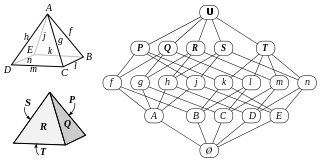 W
WIn mathematics, an abstract polytope is an algebraic partially ordered set or poset which captures the combinatorial properties of a traditional polytope without specifying purely geometric properties such as angles or edge lengths. A polytope is a generalisation of polygons and polyhedra into any number of dimensions.
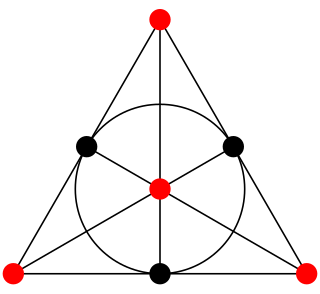 W
WAn (simple) arc in finite projective geometry is a set of points which satisfies, in an intuitive way, a feature of curved figures in continuous geometries. Loosely speaking, they are sets of points that are far from "line-like" in a plane or far from "plane-like" in a three-dimensional space. In this finite setting it is typical to include the number of points in the set in the name, so these simple arcs are called k-arcs. An important generalization of the k-arc concept, also referred to as arcs in the literature, are the -arcs.
 W
WIn geometry, a set of points are said to be concyclic if they lie on a common circle. All concyclic points are at the same distance from the center of the circle. Three points in the plane that do not all fall on a straight line are concyclic, but four or more such points in the plane are not necessarily concyclic.
 W
WIn finite geometry, the Fano plane is the finite projective plane of order 2. It is the finite projective plane with the smallest possible number of points and lines: 7 points and 7 lines, with 3 points on every line and 3 lines through every point. The standard notation for this plane, as a member of a family of projective spaces, is PG(2, 2) where PG stands for "projective geometry", the first parameter is the geometric dimension and the second parameter is the order.
 W
WIn (polyhedral) geometry, a flag is a sequence of faces of a polytope, each contained in the next, with exactly one face from each dimension.
 W
WIn mathematics, a generalized polygon is an incidence structure introduced by Jacques Tits in 1959. Generalized n-gons encompass as special cases projective planes and generalized quadrangles. Many generalized polygons arise from groups of Lie type, but there are also exotic ones that cannot be obtained in this way. Generalized polygons satisfying a technical condition known as the Moufang property have been completely classified by Tits and Weiss. Every generalized n-gon with n even is also a near polygon.
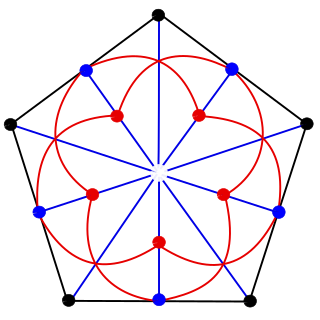 W
WIn geometry, a generalized quadrangle is an incidence structure whose main feature is the lack of any triangles. A generalized quadrangle is by definition a polar space of rank two. They are the generalized n-gons with n = 4 and near 2n-gons with n = 2. They are also precisely the partial geometries pg(s,t,α) with α = 1.
 W
WIn mathematics, an abstract system consisting of two types of objects and a single relationship between these types of objects is called an incidence structure. Consider the points and lines of the Euclidean plane as the two types of objects and ignore all the properties of this geometry except for the relation of which points are on which lines for all points and lines. What is left is the incidence structure of the Euclidean plane.
 W
WLie sphere geometry is a geometrical theory of planar or spatial geometry in which the fundamental concept is the circle or sphere. It was introduced by Sophus Lie in the nineteenth century. The main idea which leads to Lie sphere geometry is that lines should be regarded as circles of infinite radius and that points in the plane should be regarded as circles of zero radius.
 W
WIn geometry, the bundle theorem is in the simplest case a statement on six circles and eight points in the real Euclidean plane. In general it is a property of a Möbius plane that is fulfilled by ovoidal Möbius planes only.
 W
WIn incidence geometry, the Moulton plane is an example of an affine plane in which Desargues's theorem does not hold. It is named after the American astronomer Forest Ray Moulton. The points of the Moulton plane are simply the points in the real plane R2 and the lines are the regular lines as well with the exception that for lines with a negative slope, the slope doubles when they pass the y-axis.
 W
WIn mathematics, a near polygon is an incidence geometry introduced by Ernest E. Shult and Arthur Yanushka in 1980. Shult and Yanushka showed the connection between the so-called tetrahedrally closed line-systems in Euclidean spaces and a class of point-line geometries which they called near polygons. These structures generalise the notion of generalized polygon as every generalized 2n-gon is a near 2n-gon of a particular kind. Near polygons were extensively studied and connection between them and dual polar spaces was shown in 1980s and early 1990s. Some sporadic simple groups, for example the Hall-Janko group and the Mathieu groups, act as automorphism groups of near polygons.
 W
WIn projective geometry an oval is a circle-like pointset (curve) in a plane that is defined by incidence properties. The standard examples are the nondegenerate conics. However, a conic is only defined in a pappian plane, whereas an oval may exist in any type of projective plane. In the literature, there are many criteria which imply that an oval is a conic, but there are many examples, both infinite and finite, of ovals in pappian planes which are not conics.
 W
WIn projective geometry an ovoid is a sphere like pointset (surface) in a projective space of dimension d ≥ 3. Simple examples in a real projective space are hyperspheres (quadrics). The essential geometric properties of an ovoid are:Any line intersects in at most 2 points, The tangents at a point cover a hyperplane, and contains no lines.
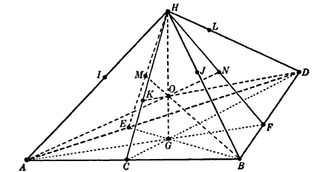 W
WIn finite geometry, PG(3,2) is the smallest three-dimensional projective space. It can be thought of as an extension of the Fano plane. It has 15 points, 35 lines, and 15 planes. It also has the following properties:Each point is contained in 7 lines and 7 planes Each line is contained in 3 planes and contains 3 points Each plane contains 7 points and 7 lines Each plane is isomorphic to the Fano plane Every pair of distinct planes intersect in a line A line and a plane not containing the line intersect in exactly one point
 W
WIn Euclidean plane geometry, Apollonius's problem is to construct circles that are tangent to three given circles in a plane (Figure 1). Apollonius of Perga posed and solved this famous problem in his work Ἐπαφαί ; this work has been lost, but a 4th-century AD report of his results by Pappus of Alexandria has survived. Three given circles generically have eight different circles that are tangent to them (Figure 2), a pair of solutions for each way to divide the three given circles in two subsets.
 W
WIn mathematics, a projective plane is a geometric structure that extends the concept of a plane. In the ordinary Euclidean plane, two lines typically intersect in a single point, but there are some pairs of lines that do not intersect. A projective plane can be thought of as an ordinary plane equipped with additional "points at infinity" where parallel lines intersect. Thus any two distinct lines in a projective plane intersect in one and only one point.
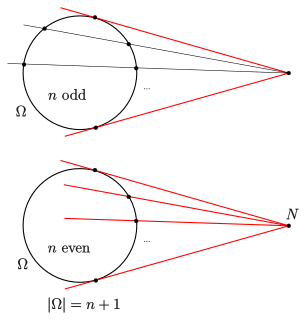 W
WIn projective geometry Qvist's theorem, named after the Finnish mathematician Bertil Qvist, is a statement on ovals in finite projective planes. Standard examples of ovals are non-degenerate (projective) conic sections. The theorem gives an answer to the question How many tangents to an oval can pass through a point in a finite projective plane? The answer depends essentially upon the order of the plane.
 W
WIn projective geometry, Segre's theorem, named after the Italian mathematician Beniamino Segre, is the statement:Any oval in a finite pappian projective plane of odd order is a nondegenerate projective conic section.